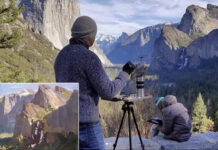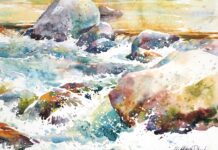
If you’re new to painting en plein air, or are experienced and curious about what others use on location, check out Kathleen Hudson’s packing list, including her art toolkit and plein air setup.
Learn how to paint landscapes with Hudson’s PaintTubeTV workshops here.

Kathleen Hudson’s Toolkit for Painting en Plein Air
Sketchbook, pencil(s), pen: For notes and thumbnail sketches.
Michael Harding oil paint: titanium white No. 1, cadmium yellow lemon, Indian yellow (“transparent, so it can be mixed without lightening deeper colors; fantastic for mixing greens”), cadmium red light, magenta, permanent alizarin, transparent oxide red, yellow ochre, phthalocyanine blue lake, ultramarine blue, cobalt blue, raw umber, neutral gray No. 5
There are no greens on this list. “This isn’t because I oppose them,” says Hudson. “In fact, I often keep phthalocyanine green lake, emerald or veronese, Michael Harding’s Green Gold, and sap green in the studio for convenience when I know I’ll be painting a lot of green. But I can mix all of these pretty easily, just as saturated, thanks to phthalo blue and cadmium lemon or Indian yellow.
Rosemary Brushes: “I favor Ivory flats for landscape painting; the curved flats are my favorite .. size 6 and 8 are my workhorse sizes for most small to midsize paintings. I use the Master’s Choice flats; I keep a larger one to smooth edges and some smaller ones to paint finer detail. Recently I’ve discovered their Mundy Mops — these goat mops are wonderful for both blocking in quickly and for smoothing edges. I also like keeping a longer filbert, Egbert, and Dagger brush for more calligraphic brushstrokes.”
- Classic Long Flat — size 10 or 12 (for covering large areas; these are stiff and allow for scrubbing)
- Ivory Long Flats or Ivory Long Flats “Curved Edge” — sizes 6, 8
- Evergreen Longer Filberts — sizes 4,6,8
- Series 279 Master’s Choice Mongoose Long Flats — sizes 4, 8 “These are ideal for softening edges or gently laying thick paint on a point of focus. If you thin your paint and have a light touch, a brush like this might be your favorite.”
- Mundy Goat Mops — sizes 3⁄4 inch, 1⁄2 inch, 3/8 inch “These are fantastic both for blocking in quickly with thinned paint and for smoothing edges at the end of a painting session. They can take a beating!”
- Ivory Dagger — size 3/8 inch
- Ivory Egbert — size 6 or 8
Shaper tool: “For taking out brushstrokes and creating small details, and even for signing plein air paintings. These are available as clay shapers via Amazon and other retailers. They are great for taking out ‘mistake’ brushstrokes or carrying thin lines in a painting (distant roads, power lines, rigging, etc.).”
Substrate: Centurion Double Oil-Primed Linen Panels. “It’s a smooth linen, and thanks to the oil priming, you can wipe out sections of your wash completely.”
Mediums: Gamblin’s Gamsol Odorless Solvent and Solvent-Free Gel Medium. “The Solvent-Free gel stays wet on your palette for quite some time and doesn’t stick to it like glue as Liquin does when it dries. Also, you can transport it without issue in air travel since it’s solvent-free.”
Misc.: Palette knife, paper towels, viewfinder, camera, pocket mirror

Hudson’s Plein Air Setup
Pack: Kelty Redwing 50 backpack. “It’s large enough to carry my gear plus some extra layers and food for day hikes.”
Easel: Joshua Been’s Daytripper Easel. “At three pounds total, it’s lighter than most pochade boxes, and yet, when it’s paired with a good tripod, the largest of the different Upright Panel Holder options can accommodate a canvas or panel as tall as 36 inches vertical. The main benefit of this setup is its flexibility and portability. I wouldn’t want to hike up a mountain with a Gloucester easel, and paired with the good tripod and weighted down, the Daytripper is almost as stable in wind.”
Tripod: Gitzo Traveler tripod and Gitzo ballhead
Folding nylon car sunshade and plastic utility clamps: “I clamp a sunshade to my panel holder and easel wings to keep my palette in the shade (I always paint with my painting in the shade). Sometimes I’ll use a clamp to attach my sketchbook with the thumbnail sketch to my easel if I want it right next to my painting. And I clamp my brush holder to the side of my palette, too.”

Learn how to paint landscapes with Hudson’s PaintTubeTV workshops here.
And browse more free articles here at OutdoorPainter.com




These are great tips on what to pack for plein air! I especially appreciate the advice about the series 279 Rosemary mongoose brush. I have some, and wasn’t sure of the best way to use them. I have three of Kathleen Hudson’s videos and i absolutely love her style and way of teaching. She is very inspiring!